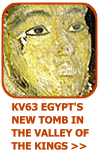|
|
|

Pharaoh profiles: Akhenaten | Alexander the Great | Cleopatra VII | Hatshepsut | Ramesses the Great | Tutankhamun | Tuthmosis III
Tutankhamun (throne name Neb-kheperu-re) the famous "boy king".
 Tutankhamun was a ruler of the 18th Dynasty (1336-1327 BC). Ironically until Howard Carter's discovery of his tomb in 1922, Tutankhamun was one of the most poorly known of the pharaohs, he had a short reign, and his tomb is unlike most other royal tombs - consisting of only four small rooms rather than the long corridor style that was typical that period. After several years of fruitless digging in the Valley of the Kings, Carter's team had finally discovered a rock-cut step below the entrance to the tomb of Ramesses VI. This was the first of a flight of steps that led down to a walled up entrance to a tomb, plastered over and stamped with large oval seals, five of which were inscribed with Tutankhamun's throne name, Neb-khepru-re. Tutankhamun was a ruler of the 18th Dynasty (1336-1327 BC). Ironically until Howard Carter's discovery of his tomb in 1922, Tutankhamun was one of the most poorly known of the pharaohs, he had a short reign, and his tomb is unlike most other royal tombs - consisting of only four small rooms rather than the long corridor style that was typical that period. After several years of fruitless digging in the Valley of the Kings, Carter's team had finally discovered a rock-cut step below the entrance to the tomb of Ramesses VI. This was the first of a flight of steps that led down to a walled up entrance to a tomb, plastered over and stamped with large oval seals, five of which were inscribed with Tutankhamun's throne name, Neb-khepru-re.
Tutankhaten becomes Tutankhamun
Tutankhamun was born during the Amarna Period, when he was first known as Tutankhaten (living image of the Aten) but later changed his name, presumably to try and distance himself from the "Atenist" reigns of Akhenaten and Smenkhara. His wife Ankhesenpaaten, who was one of Akhenaten's daughters, similarly changed her name to Ankhesenamun. Interestingly however, some of the most famous images of Tutankhamun and Ankhesenamun include the distinctive Aten style sun disc with arms outstretched down towards them.

Aged about nine when he was crowned at Memphis, Tutankhaten and his wife Ankesenpaaten changed the "aten" ending of their names to "amun" in year 2. Tutankamun probably had little to do with this, or indeed many other decisions as his "advisors" were the ones who held the reins and manipulated the boy king.
 Apart from the pivotal return to Thebes and the cult of Amun, few events from Tutankhamun's reign have been documented. Like Akhenaten and Ay, his name had been omitted from the king lists of Abydos and Karnak, which simply jump from Amenhotep III to Horemheb (Tutankhamun's sucessor). Indeed, Tutankhamun's exact identity and his parentage still remain a bit of a mystery. It is clear, however that he was bought up at el-Amarna, as a number of items found in his tomb are relics of his life at the Atenist court - notably the portrayal of the Aten disc protecting him and his young wife on the back panel of his stunning golden inlaid throne. Apart from the pivotal return to Thebes and the cult of Amun, few events from Tutankhamun's reign have been documented. Like Akhenaten and Ay, his name had been omitted from the king lists of Abydos and Karnak, which simply jump from Amenhotep III to Horemheb (Tutankhamun's sucessor). Indeed, Tutankhamun's exact identity and his parentage still remain a bit of a mystery. It is clear, however that he was bought up at el-Amarna, as a number of items found in his tomb are relics of his life at the Atenist court - notably the portrayal of the Aten disc protecting him and his young wife on the back panel of his stunning golden inlaid throne.
Death of the "boy king"
|
Tutankhamun died young, probably during his ninth regnal year. Forensic analysis of his mummy has put his age at death at around 17-19 years. Clay seals on wine jars found in his tomb record the king's regnal year when each wine was laid down. The highest recorded date is year 9 which suggests that the king may have died in that year. There is no positive evidence on Tutankhamun's mummy as to how he died.
|
|
It was once thought that he had had consumption, but this has now been dispelled. Post mortems and X-rays have located a small sliver of bone within the upper cranial cavity. It may have arrived there as the result of a blow, but whether he was deliberately struck indicating murder or whether it was the result of an accident, is pure speculation. Recent studies and CT scans have shown no indication of foul play.
|
For a long time the cause of Tutankhamun's death was unknown, and was the root of much speculation. How old was the king when he died? Did he suffer from any physical abnormalities? Had he been murdered? Many of these questions were finally answered in early 2005 when the results of a set of CT scans on the mummy were released.
The body was originally inspected by Howard Carter’s team in the early 1920s, though they were primarily interested in recovering the jewellery and amulets from the body. To remove the objects from the body, which in many cases were stuck fast by the hardened embalming resins used, Carter's team cut up the mummy into various pieces: the arms and legs were detached, the torso cut in half and the head was severed. Hot knives were used to remove it from the golden mask to which it was cemented by resin. Since the body was placed back in its sarcophagus in 1926, the mummy has subsequently been X-rayed three times: first in 1968 by a group from the University of Liverpool, then in 1978 by a group from the University of Michigan and finally in 2005 a team of Egyptian scientists led by Secretary General of the Egyptian Supreme Council of Antiquities Dr. Zahi Hawass conducted a CT scan on the mummy.
X-rays of his mummy, which were taken previously in 1968, had revealed a dense spot at the lower back of the skull. This had been interpreted as a chronic subdural hematoma, which would have been caused by a blow. Such an injury could have been the result of an accident, but it had also been suggested that the young pharaoh was murdered. If this is the case, there are a number of theories as to who was responsible: one popular candidate was his immediate successor Ay (other candidates included his wife and chariot-driver). Interestingly, there are seemingly signs of calcification within the supposed injury, which if true meant Tutankhamun lived for a fairly extensive period of time (on the order of several months) after the injury was inflicted.
Much confusion had been caused by a small loose sliver of bone within the upper cranial cavity, which was discovered from the same X-ray analysis. Some people have mistaken this visible bone fragment for the supposed head injury. In fact, since Tutankhamun's brain was removed post mortem in the mummification process, and considerable quantities of now-hardened resin introduced into the skull on at least two separate occasions after that, had the fragment resulted from a pre-mortem injury, it almost certainly would not still be loose in the cranial cavity. It therefore almost certainly represented post-mummification damage.

The world watched with great interest as on January 5, 2005, the mummy of Tutankhamun was removed from its tomb in the Valley of the Kings (KV 62) for the first time in almost eighty years. An all-Egyptian team, led by Zahi Hawass, lifted the fragile remains, still resting in the tray of sand in which it had been placed by Carter’s team, from their resting place inside the outermost coffin and sarcophagus of the king, and carried them to a state of the art CT scan machine housed inside a trailer. The scan took fifteen minutes and produced over 1700 images. These images were studied by an Egyptian team, under the auspices of Madiha Khattab, Dean of the Faculty of Medicine, Cairo University, and then by a foreign team composed of experts from Italy and Switzerland.
The team found no signs of a blow to the head, as had been theorised based on the x-rays taken in 1968, and no other evidence for foul play. They did note a bad fracture just above the left knee that may have occurred a day or two before the king died (rather than being caused by the embalmers or Carter's team). "It is possible that this injury became infected and killed the king," said Zahi Hawass.
Click here to read the full version of the CT scan report >>
The search for his tomb
Several finds in the Valley of the Kings over the years had led Howard Carter to believe that the king was still somewhere in the Valley - a small faience cup bearing his name, remnants of embalming materials and a funerary feast, and gold fragments from chariot and furniture fittings with his name upon them.

After many years of frustrating and meticulous work, the first flight of sixteen descending steps was discovered on the 4th November 1922. By the next day the steps had been cleared and revealed the top of a blocked door, a sloping corridor behind which was filled with debris, and another blocked doorway. Beyond it was a large antechamber, and a smaller room, the annexe. To the right was another blocked doorway guarded by two lifelike statues and beyond it, the burial chamber itself. The rest, as they say, is history.

Tutankhamun's tomb had been partially robbed and resealed in ancient times, but most of the funerary equipment, including the coffins and sarcophagi were found in excellent condition, almost like they had just been left there a short time ago. The tomb of Tutankhamun has gone down in history as probably the best preserved of any of the royal tombs. The wonderful treasures are today on view for all to see in the Egyptian Museum in Cairo.
IMPORTANT NOTE: The precise dates of the Egyptian Dynasties and of individual reigns are still the subject of much scholarly debate. Students and other individuals who use this website should therefore be aware that the dates shown for the dynasties and individual reigns throughout this site may sometimes differ to the dates that are used in other publications.
|
|
|









 Tutankhamun was a ruler of the 18th Dynasty (1336-1327 BC). Ironically until Howard Carter's discovery of his tomb in 1922, Tutankhamun was one of the most poorly known of the pharaohs, he had a short reign, and his tomb is unlike most other royal tombs - consisting of only four small rooms rather than the long corridor style that was typical that period. After several years of fruitless digging in the Valley of the Kings, Carter's team had finally discovered a rock-cut step below the entrance to the tomb of Ramesses VI. This was the first of a flight of steps that led down to a walled up entrance to a tomb, plastered over and stamped with large oval seals, five of which were inscribed with Tutankhamun's throne name, Neb-khepru-re.
Tutankhamun was a ruler of the 18th Dynasty (1336-1327 BC). Ironically until Howard Carter's discovery of his tomb in 1922, Tutankhamun was one of the most poorly known of the pharaohs, he had a short reign, and his tomb is unlike most other royal tombs - consisting of only four small rooms rather than the long corridor style that was typical that period. After several years of fruitless digging in the Valley of the Kings, Carter's team had finally discovered a rock-cut step below the entrance to the tomb of Ramesses VI. This was the first of a flight of steps that led down to a walled up entrance to a tomb, plastered over and stamped with large oval seals, five of which were inscribed with Tutankhamun's throne name, Neb-khepru-re.
 Apart from the pivotal return to Thebes and the cult of Amun, few events from Tutankhamun's reign have been documented. Like Akhenaten and Ay, his name had been omitted from the king lists of Abydos and Karnak, which simply jump from Amenhotep III to Horemheb (Tutankhamun's sucessor). Indeed, Tutankhamun's exact identity and his parentage still remain a bit of a mystery. It is clear, however that he was bought up at el-Amarna, as a number of items found in his tomb are relics of his life at the Atenist court - notably the portrayal of the Aten disc protecting him and his young wife on the back panel of his stunning golden inlaid throne.
Apart from the pivotal return to Thebes and the cult of Amun, few events from Tutankhamun's reign have been documented. Like Akhenaten and Ay, his name had been omitted from the king lists of Abydos and Karnak, which simply jump from Amenhotep III to Horemheb (Tutankhamun's sucessor). Indeed, Tutankhamun's exact identity and his parentage still remain a bit of a mystery. It is clear, however that he was bought up at el-Amarna, as a number of items found in his tomb are relics of his life at the Atenist court - notably the portrayal of the Aten disc protecting him and his young wife on the back panel of his stunning golden inlaid throne.

